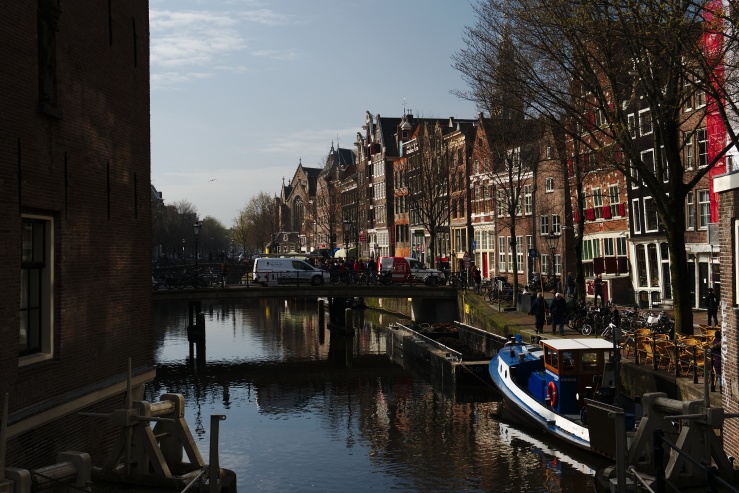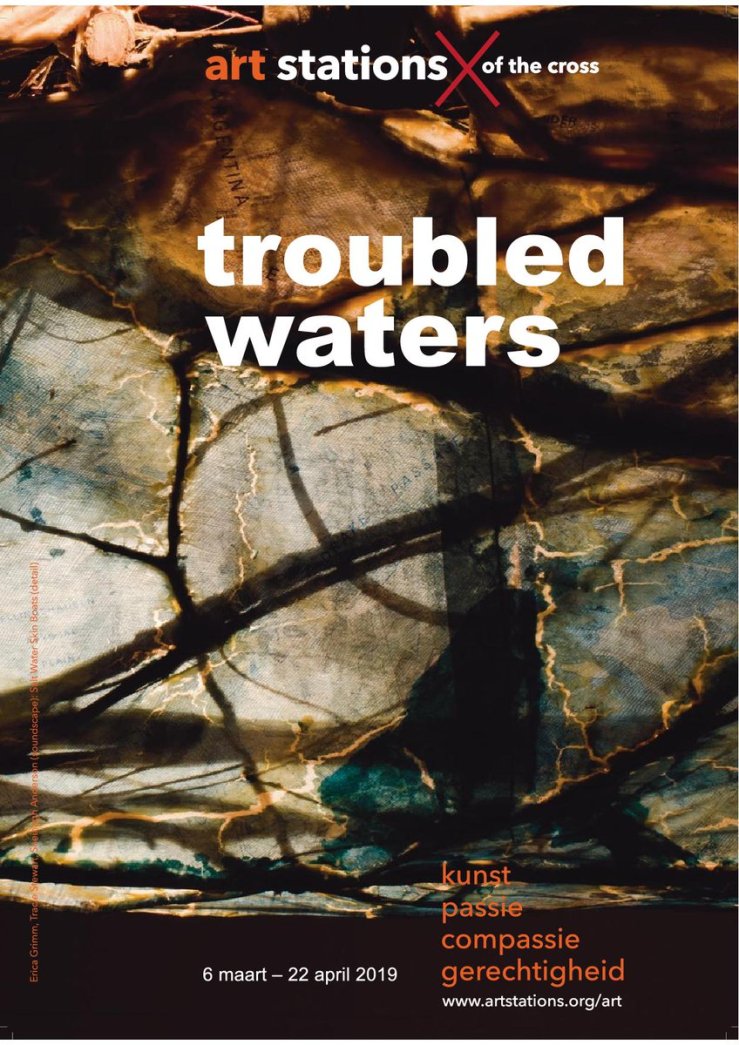Last month I undertook a contemporary art pilgrimage through Amsterdam, curated by Marleen Hengelaar-Rookmaaker and Anikó Ouweneel-Tóth under the aegis of Art Stations of the Cross, a project founded in 2016 by Dr. Aaron Rosen and the Rev. Dr. Catriona Laing. (Previous city-specific editions have been in London; Washington, DC; and New York.)
Inspired by the traditional Stations of the Cross, the pilgrimage comprises fifteen stops at thirteen locations across the city, where participants are invited to spend time before a specially chosen contemporary artwork that addresses some form of human or environmental suffering. The route starts at the Basilica of Saint Nicholas (Amsterdam’s patron saint) just across from the train station and weaves through, among other places, a park, the old Jewish quarter, a former orphanage, a church-cum–rock concert hall, a hidden house church where persecuted Catholics used to worship, and the red-light district, ending inside the Oude Kerk (Old Church), the city’s oldest extant building, located right in the heart. Not only the art but also the sites themselves were selected with intention, each one a part of the journey down this via dolorosa, “way of sorrows.”
This was my first time to Amsterdam, and it was such a good way to see the city, learn about the city, and pray for the city—all through the agent of art, which functions in this experience as a series of visual laments. When I encounter suffering or read about it in the news, I am often at a loss for how to bring it before God in prayer. I feel its heaviness but lack the words to express that feeling or to intercede in any concrete way. That’s why I’m so appreciative of artists, whose work so often becomes, for me, a nonverbal prayer addressed to my Maker, as I behold and internalize what the artist has first beheld and internalized and has then shared with me through whatever their medium. This is a gift that artists offer the church: vision, long and deep, that’s sensitive to the glories but also the woes of the world and that invites others in, through the skillful crafting of materials, to see right along with them. That act of seeing—of noticing, of giving attention to—can itself be prayer.
Amsterdam was founded as a fishing village at the end of the twelfth century with the building of a dam on the Amstel River. (The name Amstelledamme later evolved into Amsterdam.) Its sixty-plus miles of interconnected canals have earned it the nickname “Venice of the North” and make it the most watery city in the world. These navigable waterways led to Amsterdam becoming, in the seventeenth century, the foremost maritime and economic power in the world, and the wealth that came through international trade also enabled the arts and sciences to flourish throughout the country; that’s why the seventeenth century is known as the Dutch Golden Age. (Think Rembrandt and Vermeer.)

The exhibition’s subtitle, Troubled Waters, alludes to the fraught nature of Amsterdam’s identity as a historic port city into which both goods and people travel. The pioneering Dutch East India Company, an amalgamation of trading companies that is now defunct, is important in global business history as the forerunner of modern corporations, but it also cannot be separated from its involvement in the slave trade. Although slavery was formally abolished in the Netherlands in 1863, it continues in Amsterdam’s sex industry, in which a percentage of workers are victims of human trafficking; girls and women sometimes arrive in shipping containers, enslaved by pimps and even further by ignorant customers.
Other residents of Amsterdam arrive as refugees, and for many of them, water is a formidable danger that must be traversed on the way to safety.
“Troubled waters” also references the acidification, pollution, and rising temperatures of the world’s oceans, which endanger the many marine species that live there. So even the water itself bears wounds.
Although the overall tone of the pilgrimage is one of sorrow, pockets of hope are dispersed throughout, as in the empowered Surinamese painted by Iris Kensmil (station 5), Paul van Dongen’s Rising drawing that counterbalances his Judgment (station 7), Janpeter Muilwijk’s afterlife vision of his dead daughter victoriously bounding over the earth (station 9), the soothing “streams of mercy, never ceasing” that provide an auditory accompaniment to Anjet van Linge’s chiseled “Kyrie eleison” (station 12), and, of course, the inclusion of a resurrection station (station 15).
(Related posts: “Stations of the Cross at the Smithsonian American Art Museum”; “Remembering Charleston”)
Though modeled loosely after a medieval devotional practice, Art Stations of the Cross: Troubled Waters is thoroughly modern, incorporating audio and video components, 3-D technologies, and the distinctively contemporary genre of installation art. Figurative art is still present and in some cases interacts with the traditional religious images in its environs, but it often does so transgressively—for example, the photorealistic Madonna and Child wrapped in emergency blankets in station 1 and the decapitated corpus of Christ in station 13.
For more information about Art Stations, which runs through April 22, visit http://www.artstations.org/. There you can find a map, opening times, descriptions, tie-in events, and information on where you can purchase a catalog (available in Dutch or English). Most stops along the route host a stack of brochures that condense this info and that contain a stamp card on the back, where you can mark off the stations you’ve visited. All the exhibition sites are freely accessible. (Oude Kerk waives its admission fee if you present your Art Stations brochure at the entrance desk.)
Below and in two subsequent posts, I will share some of my photos and impressions of each station. Unless otherwise specified, all photos are by my husband, Eric James Jones, and are the property of ArtandTheology.org. Feel free to use them noncommercially, with credit to the artists and a link back to this webpage.
+++

STATION 1. The route starts at the neo-Baroque Church of St. Nicholas, which temporarily houses one of my favorite and arguably the most confrontational of all the works on the tour: Hans Versteeg’s Madonna del Mare Nostrum: Of, Mantel der Liefde (Our Lady of the Mediterranean Sea: Or, Cloak of Love). A young dark-skinned mother holds her toddler son, both of them wrapped in a thermal blanket like the ones given to refugees to prevent hypothermia. Replacing Mary’s traditional ultramarine robe with a “robe” of metallized polyethylene terephthalate, whose gold surface glints in the sun, emphasizes how she and her boy are clothed not only in holiness but also in need. Because of how the artist chose to frame the composition, we don’t know if the figures are standing in a boat that’s still at sea or on the shore. Regardless, their strongly frontal positioning and their direct stares seem to ask the viewer, “Will you receive us?” Continue reading “Walking the Via Dolorosa through Amsterdam (Part 1)”

